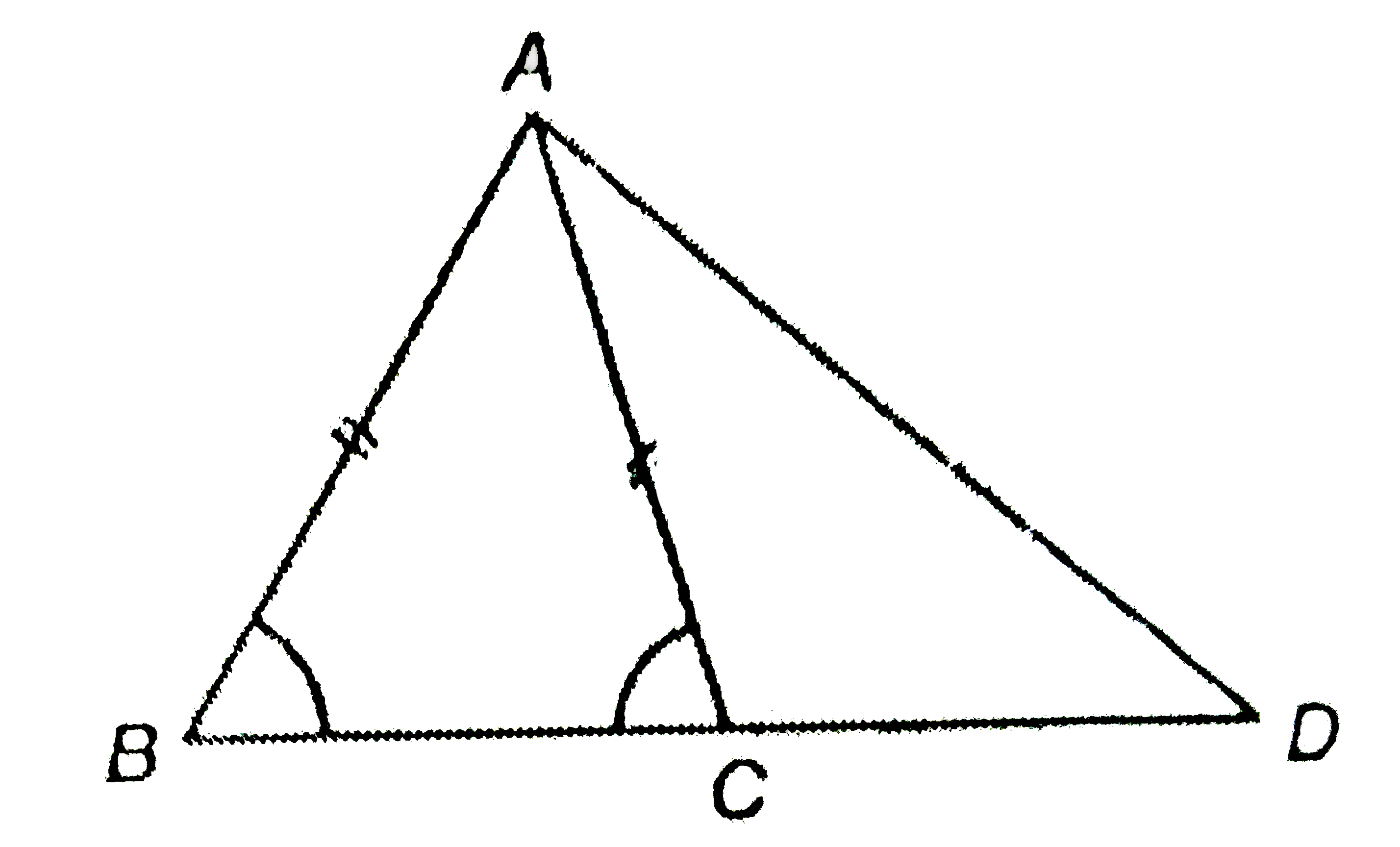In △ABC,AB>AC and D is any point on BC. Prove that, AB > AD.
To prove that AB>AD in triangle ABC where AB>AC and D is any point on BC, we can follow these steps:
Step 1: Understand the properties of triangles
In any triangle, the side opposite to a larger angle is longer than the side opposite to a smaller angle. This is a fundamental property of triangles.
Hint: Remember that the relationship between angles and sides in a triangle is crucial for this proof.
Step 2: Identify the angles
Since AB>AC, by the property mentioned above, the angle opposite to AB (which is ∠ACB) must be greater than the angle opposite to AC (which is ∠ABC). Therefore, we have:
∠ACB>∠ABC
Hint: Focus on which angles correspond to which sides in the triangle.
Step 3: Analyze point D
Let D be any point on BC. This creates two smaller triangles: △ACD and △ABD.
Hint: Visualize how point D divides the segment BC and how it affects the angles.
Step 4: Compare angles in triangles ACD and ABD
In triangle ACD:
- The angle ∠ACD is less than ∠ACB because D is on line BC.
- Thus, we have:
∠ACD<∠ACB
In triangle ABD:
- The angle ∠ABD is less than ∠ABC for the same reason.
- Thus, we have:
∠ABD<∠ABC
Hint: Use the fact that angles in triangle ACD and ABD are related to the angles in triangle ABC.
Step 5: Establish the relationship between angles
From the inequalities established:
∠ACD<∠ACB>∠ABC>∠ABD
This implies:
∠ACD>∠ABD
Hint: Compare the angles directly to see which is larger.
Step 6: Apply the triangle inequality
Since ∠ACD>∠ABD, by the property of triangles, the side opposite to the larger angle must be longer. Therefore:
AD<AB
This can be rewritten as:
AB>AD
Hint: Remember that the side opposite to a larger angle is always longer.
Conclusion
Thus, we have proved that AB>AD in triangle ABC where AB>AC and D is any point on BC.
---
In any triangle, the side opposite to a larger angle is longer than the side opposite to a smaller angle. This is a fundamental property of triangles.
Since AB>AC, by the property mentioned above, the angle opposite to AB (which is ∠ACB) must be greater than the angle opposite to AC (which is ∠ABC). Therefore, we have:
∠ACB>∠ABC
Let D be any point on BC. This creates two smaller triangles: △ACD and △ABD.
In triangle ACD:
- The angle ∠ACD is less than ∠ACB because D is on line BC.
- Thus, we have:
∠ACD<∠ACB
- The angle ∠ABD is less than ∠ABC for the same reason.
- Thus, we have:
∠ABD<∠ABC
From the inequalities established:
∠ACD<∠ACB>∠ABC>∠ABD
This implies:
∠ACD>∠ABD
Since ∠ACD>∠ABD, by the property of triangles, the side opposite to the larger angle must be longer. Therefore:
AD<AB
This can be rewritten as:
AB>AD
Thus, we have proved that AB>AD in triangle ABC where AB>AC and D is any point on BC.
Topper's Solved these Questions
- TRIANGLESBOOK - NAVNEET PUBLICATION - MAHARASHTRA BOARDCHAPTER - TRIANGLESEXERCISE - MULTIPLE CHOICE QUESTIONS
15 Videos
- TRIANGLESBOOK - NAVNEET PUBLICATION - MAHARASHTRA BOARDCHAPTER - TRIANGLESEXERCISE - SUMS TO ENRICH REMEMBER
9 Videos
- TRIANGLESBOOK - NAVNEET PUBLICATION - MAHARASHTRA BOARDCHAPTER - TRIANGLESEXERCISE - EXERCISE 7.5
4 Videos
- SURFACE AREAS AND VOLUMESBOOK - NAVNEET PUBLICATION - MAHARASHTRA BOARDCHAPTER - SURFACE AREAS AND VOLUMESEXERCISE - MULTIPLE CHOICE QUESTIONS
18 Videos
Similar Questions
Knowledge Check
In a △ABC,AB = AC and AD⊥BC, then :
AAB<ADBAB>ADCAB=ADDAB≤ADIn ΔABC, AB=AC and D is a point on side AC such that BD = BC, If AB = 12.5 cm and BC = 5 cm, then what is the measure of DC ?
A2 cmB2.5 cmC3 cmD1.8 cm
In △ABC, AB=AC and D is any point on BC, prove that AB2−AD2=BD.CD
View SolutionABC is a triangle in which AB=AC and D is any point in BC . Prove that AB2−AD2=BDCD .
View SolutionIn isosceles triangle ABC, D is a point on the base BC produced. Prove that AD>AB.

View SolutionIn ΔABC, if D is any point on the side BC, show that (AB+BC+AC)>2AD.

View SolutionABC is an isosceles triangle with AB=AC and D is a point on AC such that BC2=ACxCD. Prove that BD=BC
View SolutionIn △ ABC, AD is a median. Prove that AB + AC > 2AD
View Solution
